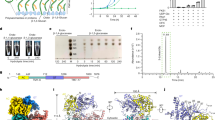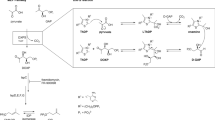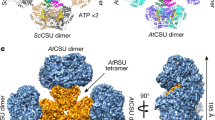Abstract
Phosphomannose isomerase (PMI) catalyses the reversible isomerization of fructose-6-phosphate (F6P) and mannose-6-phosphate (M6P). Absence of PMI activity in yeasts causes cell lysis and thus the enzyme is a potential target for inhibition and may be a route to antifungal drugs. The 1.7 ˚ crystal structure of PMI from Candida albicans shows that the enzyme has three distinct domains. The active site lies in the central domain, contains a single essential zinc atom, and forms a deep, open cavity of suitable dimensions to contain M6P or F6P. The central domain is flanked by a helical domain on one side and a jelly-roll like domain on the other.
This is a preview of subscription content, access via your institution
Access options
Subscribe to this journal
Receive 12 print issues and online access
$189.00 per year
only $15.75 per issue
Buy this article
- Purchase on Springer Link
- Instant access to full article PDF
Prices may be subject to local taxes which are calculated during checkout
Similar content being viewed by others
References
Orlean, P. Dolichol phosphate mannose synthase is required in vivo for glycosyl phosphatidylinositol membrane anchoring, O-mannosylation and N-glycosylation of protein in Saccharomyces cerevisiae. Mol. Cell. Biol. 10, 5796–5805 (1990).
Payton, M.A., Rheinecker, M., Klig, L.S., De Tiani, M. & Bowden, E. A novel Saccheromyces cerevisiae mutant possesses a thermolabile phosphomannose isomerase. J. Bacteriol. 173, 2006–2010 (1991).
Smith, D.J., Proudfoot, A.E.I., De Tiani, M., Wells, T.N.C. & Payton, M.A. Cloning and heterologous expression of the Candida albicans gene PMI 1 encoding phosphomannose isomerase. Yeast 11, 301–310 (1995).
Manfredi, R., Nanetti, A., Mazzoni, A., Mastroianni, A. & Chiodo, F. The incidence, etiology and clinical significance of visceral mycoses in patients with AIDS. Minerva Medica 84, 383–391 (1993).
Proudfoot, A.E.I., Payton, M.A. & Wells, T.N.C. Purification and characterisation of fungal and mammalian phosphomannose isomerases. J. Protein Chem. 13, 619–627 (1994).
Proudfoot, A.E.I., Turcatti, G., Wells, T.N.C., Payton, M.A. & Smith, D.J., Purification, cDNA cloning and heterologous expression of human phosphomannose isomerase. Eur. J. Biochem. 219, 415–413 (1994).
Shinabarger, D. et al. Purification and characterisation of phosphomannose isomerase-guanosine diphospho-D-mannose pyrophosphorylase. J. Biol. Chem. 266, 2080–2088 (1991).
Schmidt, M., Arnold, W., Niemann, A., Kleickmann, A. & Puhler, A., The Rhizobium meliloti pmi gene encodes a new type of phosphomannose isomerase. Gene, 122, 35–43 (1992).
Gracy, R.W. & Noltmann, E.A. Studies on phosphomannose isomerase. J. Biol. Chem. 243, 3161–3168 (1968).
Walsh, C. Enzmatic raction mehanisms (WH. Freeman & Co, New York, 1979).
Wells, T.N.C, Coulin, F., Payton, M.A. & Proudfoot, A.E.I. Phosphomannose Isomerase from Saccharomyces cerevisiae contains two inhibitory metal binding sites. Biochemistry 32, 1294–1301 (1993).
Wells, T.N.C., Payton, M.A. & Proudfoot, A.E.I. Inhibition of Phosphomannose isomerase by mercury ions. Biochemistry 33, 7641–7646 (1994).
Wells, T.N.C, Scully, P.A., Paravicini, G., Proudfoot, A.E.I. & Payton, M.A. Mechanism of irreversible inactivation of phosphomannose isomerase by silver ions and flammazine. Biochemistry 3, 7896–7903 (1995).
Tolley, S. et al. Crystallisation and preliminary X-ray analysis of Candida albicans Phosphomannose isomerase. J. Mol. Biol. 237, 349–350 (1994).
Richardson, J.S. The anatomy and taxonomy of protein structure. Adv. Protein Chem. 34, 167–339 (1981).
Rossmann, M.G. et al. Structural comparisons of some small spherical plant viruses. J. Mol. Biol. 165, 711–736 (1983).
Ko, T-P, Ng, J.D. and McPherson, A The Three-Dimensional Structure of Canavalin from Jack Bean (Canavalia ensiformis). Plant Physiol. 101, 729–744 (1993).
Vallee, B.L. and Auld, D.S. Zinc co-ordination, function and structure of zinc enzymes and other proteins. Biochemistry 29, 5647–5659 (1990).
Bode, W. et al. Structure of astacin and implications for activation of astacinsand zinc-ligation of collagenases. Nature 358, 164–167 (1992).
Bode, W., Gomis-Ruth, F-X. & Stockier, W. Astacins, serralysins, snake venom and matrix metalloproteinases exhibit identical zinc-binding environments (HEXXHXXGXXH and Met-turn) and topologies and should be grouped into a common family, the ‘metzincins’. FEBS Lett. 331, 134–140 (1993).
Roach, P.L. et al.. Crystal structure of isopenicillin N synthase is the first from a new structural family of enzymes. Nature 375, 700–704 (1995).
Collyer, C.A., Henrick, K. & Blow, D.M. Mechanism for aldose-ketose inter conversion by D-xylose isomerase involving ring opening followed by a 1,2-hydrideshift. 7. Mol. Biol. 212, 211–235 (1990).
Wells, T.N.C., Scully, P. & Magnenat, E. Arginine 304 is an active site residue in phosphomannose isomerase from Candida albicans. Biochemistry 33, 5777–5782 (1994).
Coulin, F. et al. Identification of Cys-150 in the active site of phosphomannose isomerase from Candida albicans. Biochemistry 32, 14139–14144 (1993).
Bernard, A.R. et al. Selenomethionine labelling of phosphomannose isomerase changes its kinetic properties. Eur. J. Biochem. 230, 111–118 (1995).
Seeholzer, S.H. Phosphoglucose isomerase: A ketol isomerase with aldol C2-epimerase activity. Biochemistry 30, 1237–1241 (1993).
Noltmann, E.A. Aldose-Ketose Isomerases. in The Enzymes IV (ed Boyer, P.D.) 271–314 (Academic Press, New York and London, 1972).
Malaisse-Lagae, F., Liemans, V., Yaylali, B., Sener, A. & Malaisse, W.J. Phosphoglucose isomerase-catalysed inter conversion of hexose phosphates; comparison with phosphomannose isomerase Biochim. Biophys. Acta 998, 118–125 (1989).
Lavie, A., Allen, K.N., Petsko, G.A. & Ringe, D. X-ray crystallographic structures of D-xylose isomerase-substrate complexes position the substrate and provide evidence for metal movement during catalysis. Biochemistry 33, 5469–5480 (1994).
Carrell, H.L., Hoier, H. & Glusker, J.P. Modes of binding substrates and their analogues to the enzyme D-xylose isomerase. Acta Crystallogr. 050, 113–123 (1994).
Messerschmidt, A. & Pflugrath, J. Crystal orientation and X-ray pattern prediction routines for area detector diffractometer systems in macromolecular crystallography. J. Appl. Crystallogr. 20, 306–315 (1987).
Leslie, A.G.W., Brick, P. & Wonacott A.T. MOSFLM. Daresbury Ab. Inf. Quart. Protein Crystallogr. 18, 33–39 (1986).
Collaborative Computational Project, Number 4 The CCP4 Suite: Programs for protein crystallography Acta Crystallogr. D50, 760–763 (1994).
Jones, T.A. Interactive computer graphics: FRODO Meth. Enzymol. 115, 157–171 (1985).
Brünger, A.T., Kuriyan, J. & Karplus, M. Crystallographic R factor refinement by molecular dynamics. Science 235, 458–460 (1987).
Hendrickson, W.A. Stereochemically restrained refinement of macromolecular structures. Metn. Enzymol. 115, 252–271 (1985).
Kraulis, P.J. MOLSCRIPT: a program to produce both detailed and schematic plots of protein structures. J. Appl. Crystallogr. 24, 946–950 (1991).
Nicholls, A. GRASP: Graphical representation and analysis of surface properties. (Columbia University, New York, 1992).
Author information
Authors and Affiliations
Rights and permissions
About this article
Cite this article
Cleasby, A., Wonacott, A., Skarzynski, T. et al. The X-ray crystal structure of phosphomannose isomerase from Candida albicans at 1.7 Å resolution. Nat Struct Mol Biol 3, 470–479 (1996). https://doi.org/10.1038/nsb0596-470
Received:
Accepted:
Issue Date:
DOI: https://doi.org/10.1038/nsb0596-470
This article is cited by
-
Plant phosphomannose isomerase as a selectable marker for rice transformation
Scientific Reports (2016)
-
l-Ribose isomerase and mannose-6-phosphate isomerase: properties and applications for l-ribose production
Applied Microbiology and Biotechnology (2016)
-
BcPMI2, isolated from non-heading Chinese cabbage encoding phosphomannose isomerase, improves stress tolerance in transgenic tobacco
Molecular Biology Reports (2014)
-
Inactivation of phosphomannose isomerase gene abolishes sporulation and antibiotic production in Streptomyces coelicolor
Applied Microbiology and Biotechnology (2012)



